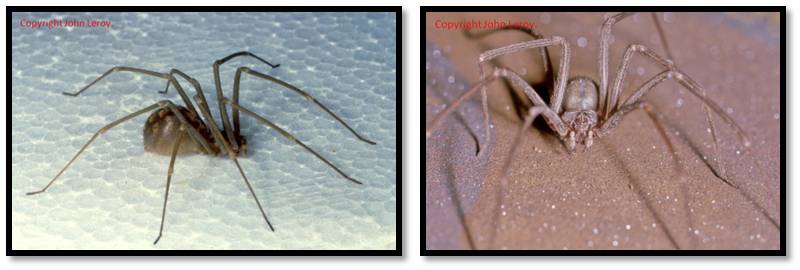VIOLIN SPIDERS
Family Sicariidae, genus Loxosceles
6 species Loxosceles bergeri, L parramae, L pilosa, L simillima, L speluncarum, and L spinulosa
Violin spiders are smallish to medium-sized, unremarkable free–living nocturnal hunters and a variety of subdued brownish colours. The “violin marking” on the head region is not always visible and is not a reliable identification mark. They don’t construct webs to catch their prey but rest under logs and bits of fallen wood etc., by day in a retreat of a few strands of soft, bluish silk. The danger from violin spiders is hugely exaggerated. They will only bite if inadvertently squashed again the skin. The venom is cytotoxic (cell destroying) to humans and can, but seldom does, cause long-lasting necrotic wounds. Bites are not life threatening but medical attention should be sought for proven Violin Spider bites. Treatment is supportive and symptomatic. No antivenin is available or necessary.
Here’s what Dr Ansie Dippenaar-Schoeman, a world-renowned scientist who has worked with spiders all her life says about them:
”Of the medically important spiders, it is especially the VIOLIN spider that causes the greatest confusion. Over the last years e-mails have been circulating claiming that violin spiders have become a serious problem in South Africa and that their numbers are increasing at an alarming rate.
Violin spiders are regarded as rare spiders by the arachnologists in South Africa with very few specimens recorded from houses. Surveys in South Africa over the last forty years support this statement. In the South African National Collection of Arachnida, which houses more than 140 000 spider specimens collected over a 40-year period, only 120 specimens (0.08% of the collection are violin spiders. Of these 120 specimens, only 11 were collected inside buildings.
Their rarity is confirmed by surveys undertaken over the last six years as part of the South African National Survey of Arachnida (SANSA). Of the more than 10 000 spiders identified annually, violin spiders are rarely encountered.
As part of SANSA, a virtual museum www.arc.agric.za:8080 is available to the public and it contains photographs of spider submitted – most of which were found in and around house. Of the more than 3000 photographs received to date, only 10 are of Violin Spiders, and five of these were photographed at the same locality in the Free State.”
More information is available on the ARC-PPRI website – http://www.arc.agric.za/arc-ppri/Pages/Biosystematics/Arachnida-Research.aspx.
Go to BIOINFORMATICA then Venomous arachnids.

Loxosceles parramae Gauteng violin spider A species of violin spider from the Karoo

SIX-EYED SAND SPIDERS, SIX-EYED CRAB or SIX-EYED DESERT SAND SPIDERS
Family Sicariidae, Sicarius hahni, Sicarius spatulatus, Sicarius testaceus
Six-eyed sand spiders are found in arid areas of fine sand where they remain immobile just below the surface. They are restricted to dry sandy habitats and can be found in the soft soil at the mouths of caves and overhangs or in the shelter or rocks. Although their venom is potentially dangerous there have been no proven records of bites in South or southern Africa from these spiders.

Sicarius testaceus a six-eyed sand spider
Tests show that the venom of six-eyed sand spider has both cytotoxic and haemotoxic elements which mean it could cause both tissue damage at the site of the bite and internal haemorrhaging. No human envenomation has been recorded so we simply don’t know either what the effects would be or what treatment should be recommended, but probably the same as for violin spiders, i.e. supportive and symptomatic. No antivenin is available.
TREATMENT OF VIOLIN AND SIX-EYED SAND SPIDER BITES
(Cytotoxic venom)
Treatment is given to promote healing and limit secondary infection. The bite site must be kept clean, dry, uncovered and not interfered with. If infection does occur, antibiotics I.V. and a tetanus toxoid should be administered. No antivenin is available for cytotoxic spider bites. There are no investigations of value in establishing diagnosis.
Next week Part 4 Sac spiders off the hook and notes for medical practitioners.








